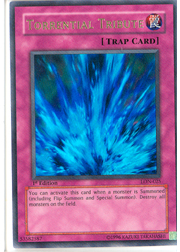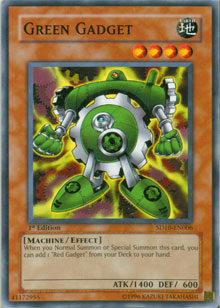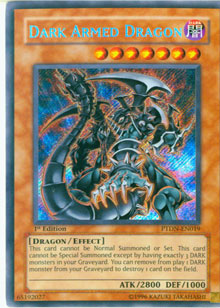 Your ideal game in the Yu-Gi-Oh! TCG would function something like a mouse trap. You would set up a trap and watch as the opponent walked into it, and was destroyed. No mess, no resistance, no strategy. But when was the last time you beat someone in a game of Yu-Gi-Oh! who didn’t put up a fight? Unfortunately, winning a duel isn’t as simple as watching your opponent lose it, and your opponent is going to be a lot smarter than a mouse. Setting the trap in broad daylight right in the open isn’t going to fool anybody. This is the thinking that led crafty players to develop a move I’ll break down today, which I like to call the "bait and trap."
Your ideal game in the Yu-Gi-Oh! TCG would function something like a mouse trap. You would set up a trap and watch as the opponent walked into it, and was destroyed. No mess, no resistance, no strategy. But when was the last time you beat someone in a game of Yu-Gi-Oh! who didn’t put up a fight? Unfortunately, winning a duel isn’t as simple as watching your opponent lose it, and your opponent is going to be a lot smarter than a mouse. Setting the trap in broad daylight right in the open isn’t going to fool anybody. This is the thinking that led crafty players to develop a move I’ll break down today, which I like to call the "bait and trap."
The bait and trap works exactly how it sounds like it should. The idea is to bait your opponent into falling into a trap. Pretty simple, right? It’s a bit more complicated than it sounds and a lot harder to pull off. For the purposes of this move, a "trap" is a scenario in which your opponent finds no good answer. The end result should be him or her losing a significant amount of life points and/or cards. Usually a plan like this results in a hard choice that sees your opponent picking the lesser of two evils: waste your Return from the Different Dimension and Torrential Tribute or lose the game. After the trap is sprung, you should have a stranglehold over the duel. Your opponent should either have so few cards that he or she is unable to make a successful move or the opponent should have so few life points that that player won’t be able to confidently take a stand.
It’s the definition of the trap that makes the move so difficult to pull off. As previously stated, your opponent is not going to sit there and let you wreak havoc on his or her field. You’ll have to work to pull off the move. The impact the bait and trap has on the duel will depend on how patient you are when baiting. The most obvious use of the bait and trap is with Torrential Tribute and Mirror Force. Both cards can take out an entire field of opposing monsters if used correctly.
Here’s an example of the bait and trap using Torrential Tribute. You go first and set Torrential Tribute and pass. You’ve baited your opponent into falling for Torrential Tribute already because you have not set a monster and are free to use Torrential at any given opportunity. However, to spring a trap you are going to have to be more crafty. In order to  trap your opponent in the duel, you’ll want to take out multiple monsters at once. Your opponent summons Elemental Hero Stratos and you decide not to use the Torrential Tribute. This is because you’re going to spring a trap next turn.
trap your opponent in the duel, you’ll want to take out multiple monsters at once. Your opponent summons Elemental Hero Stratos and you decide not to use the Torrential Tribute. This is because you’re going to spring a trap next turn.
You summon Green Gadget and set another spell and trap card on your next turn. Your opponent, who is worried about your increased field presence, may decide to attempt a clean sweep to try and take a dominant field position. That is to say he or she will try to take care of all your stuff in one turn. Your opponent summons Dark Grepher and—using his effect—he or she is able to special summon Dark Armed Dragon that turn. At this point, you flip Torrential Tribute and claim a successful bait and trap. You lured the opponent into playing more monsters by threatening the opponent with potential field development, and fooled that player into committing his or her best cards to the table. You have indeed trapped your opponent here because it’s likely that he or she is now holding fewer cards and that those cards are less powerful than yours.
Skeptics will look at this example and think that it’s foolish. They’ll claim there’s no way your opponent is going to fall into a Torrential Tribute like that. While it’s possible that some players will avoid the play, it’s up to you to make them fall for it by presenting proper bait. Going back to the Torrential Tribute example, saving Torrential even when it seems like it’s a good time to use it can make all the difference between an average trap that takes care of one or two cards and a big trap that wins the game. For example, your opponent summons Snipe Hunter and uses priority on your face-down Card Trooper over your Torrential Tribute. You decide not to activate the Torrential because you notice the discard for Snipe  leaves your opponent’s graveyard with three Dark monsters and you believe he or she is holding Dark Armed Dragon. Sure enough, Dark Armed comes down next and your opponent stares in wonder as you flip Torrential Tribute.
leaves your opponent’s graveyard with three Dark monsters and you believe he or she is holding Dark Armed Dragon. Sure enough, Dark Armed comes down next and your opponent stares in wonder as you flip Torrential Tribute.
We can apply knowledge gleaned from the Pro Storm technique to the bait and trap tactic as well. Appearing to commit cards to the field in the form of replicable monsters like Sangan and Card Trooper is a perfect way to bait an opponent into falling for big Torrential Tribute cards. Back when we could play three copies of Card Trooper, it wasn’t uncommon to get hit by Torrential Tribute when your opponent had three monsters face down, because they were all replaced with cards from the deck.
The bait and trap has many uses outside of Torrential Tribute though. Pretty much any card that has the ability to destroy more than one or two cards provides the perfect basis to attempt to trap your opponent. Lightning Vortex, Dark Armed Dragon, Darklord Zerato, and Crush Card Virus are all examples of this. Next installment I’ll take a look at tournament examples of the bait and trap, and show you how patience and craftsmanship can win games.
—Matt Peddle